Inland Wetlands Ecosystem Report
VerifiedAdded on 2020/02/05
|11
|2098
|78
Report
AI Summary
This report provides a comprehensive analysis of the inland wetland ecosystem, specifically focusing on the Kakadu National Park in Australia, a Ramsar Wetland of international importance. The report defines ecosystems and wetlands, highlighting their crucial role globally. It details the biological concepts within the Kakadu ecosystem, including its diverse flora and fauna, emphasizing endangered species like *Utricularia subulata* and *Dubouzetia Australians*. The report also discusses the park's funding sources, including government initiatives and tourism revenue, and addresses challenges such as weed management and fire outbreaks. The conclusion underscores the importance of wetland conservation for maintaining biodiversity and ecosystem services, emphasizing the Australian government's efforts to protect and promote the Kakadu National Park.
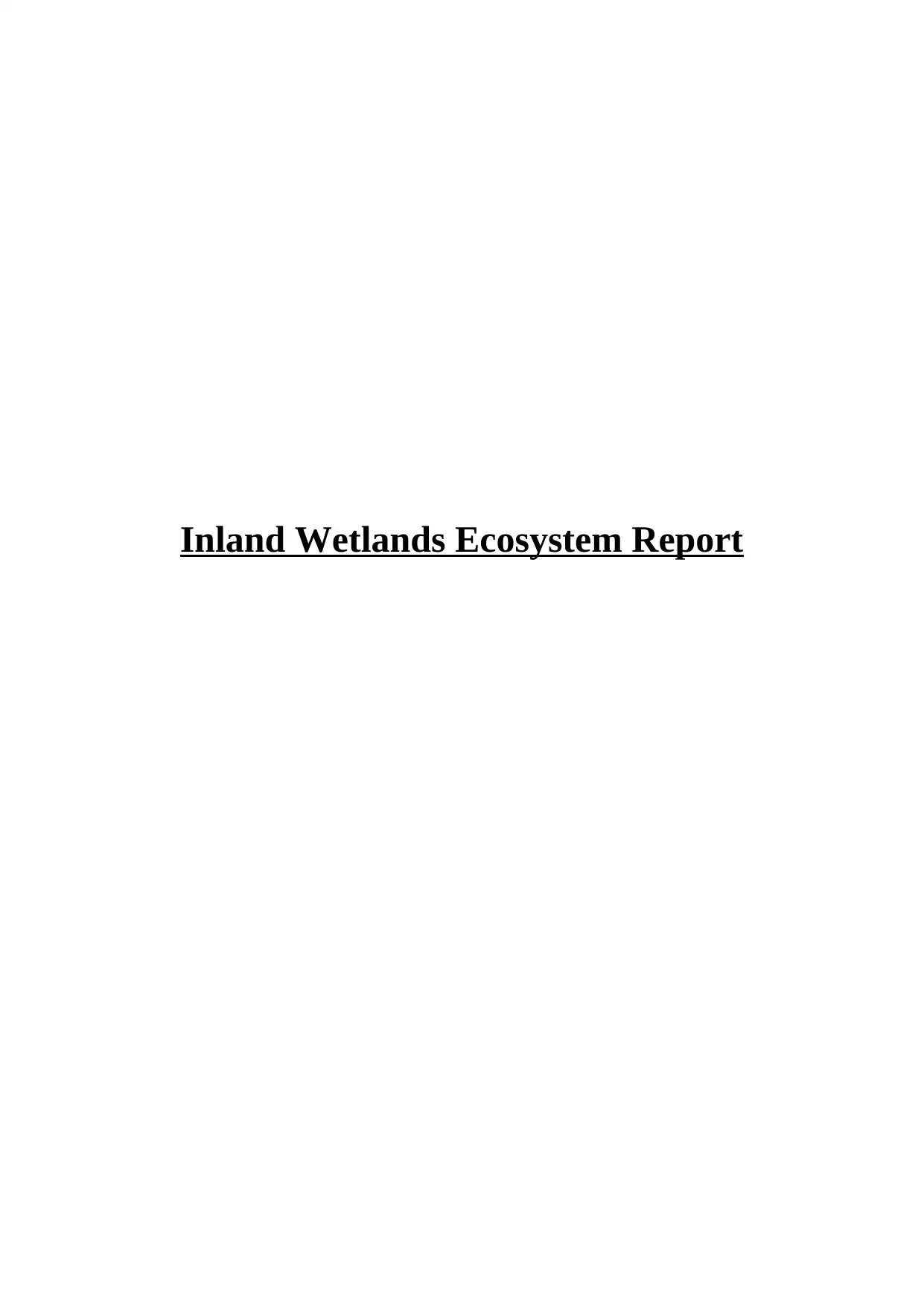
Inland Wetlands Ecosystem Report
Paraphrase This Document
Need a fresh take? Get an instant paraphrase of this document with our AI Paraphraser
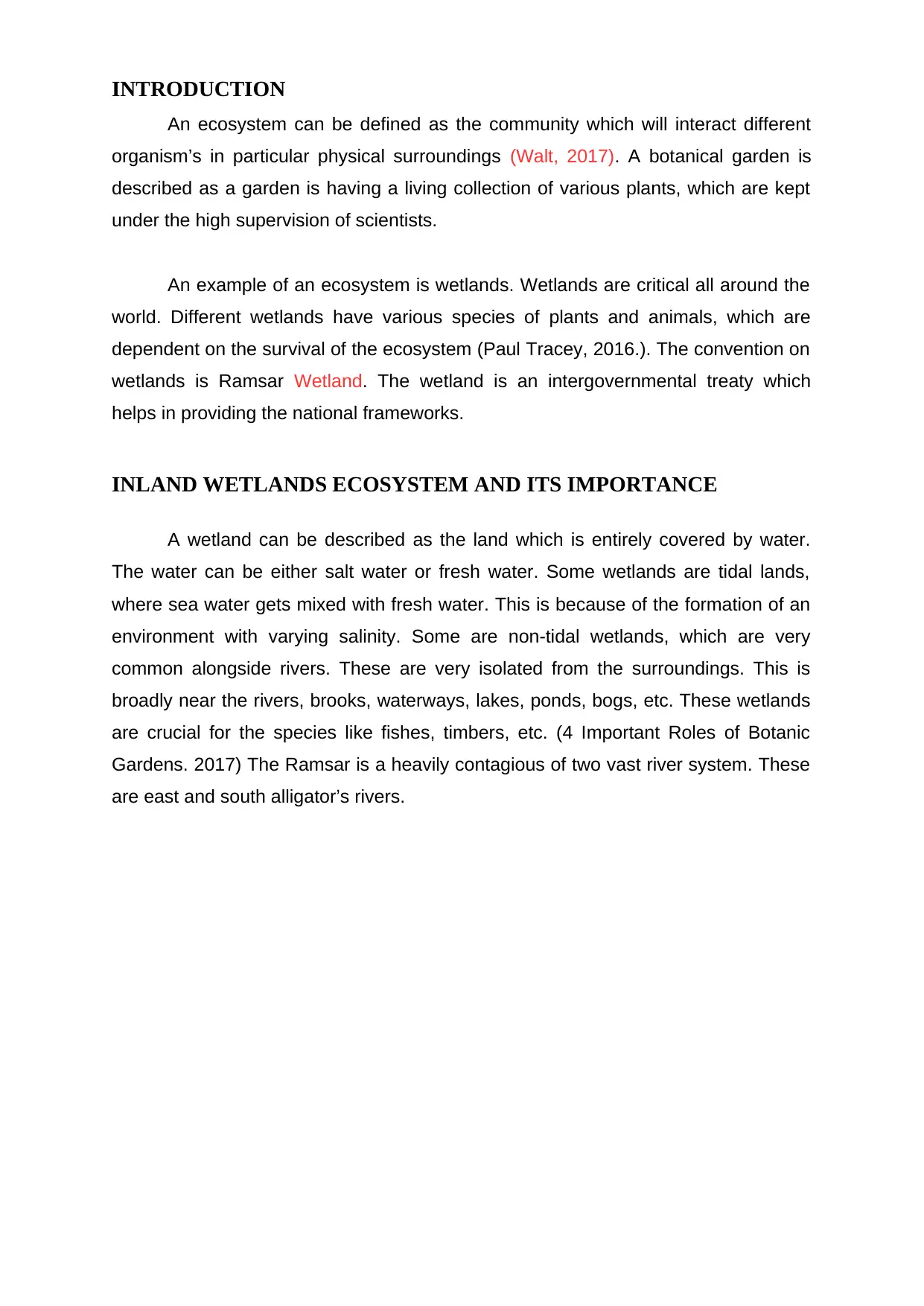
INTRODUCTION
An ecosystem can be defined as the community which will interact different
organism’s in particular physical surroundings (Walt, 2017). A botanical garden is
described as a garden is having a living collection of various plants, which are kept
under the high supervision of scientists.
An example of an ecosystem is wetlands. Wetlands are critical all around the
world. Different wetlands have various species of plants and animals, which are
dependent on the survival of the ecosystem (Paul Tracey, 2016.). The convention on
wetlands is Ramsar Wetland. The wetland is an intergovernmental treaty which
helps in providing the national frameworks.
INLAND WETLANDS ECOSYSTEM AND ITS IMPORTANCE
A wetland can be described as the land which is entirely covered by water.
The water can be either salt water or fresh water. Some wetlands are tidal lands,
where sea water gets mixed with fresh water. This is because of the formation of an
environment with varying salinity. Some are non-tidal wetlands, which are very
common alongside rivers. These are very isolated from the surroundings. This is
broadly near the rivers, brooks, waterways, lakes, ponds, bogs, etc. These wetlands
are crucial for the species like fishes, timbers, etc. (4 Important Roles of Botanic
Gardens. 2017) The Ramsar is a heavily contagious of two vast river system. These
are east and south alligator’s rivers.
An ecosystem can be defined as the community which will interact different
organism’s in particular physical surroundings (Walt, 2017). A botanical garden is
described as a garden is having a living collection of various plants, which are kept
under the high supervision of scientists.
An example of an ecosystem is wetlands. Wetlands are critical all around the
world. Different wetlands have various species of plants and animals, which are
dependent on the survival of the ecosystem (Paul Tracey, 2016.). The convention on
wetlands is Ramsar Wetland. The wetland is an intergovernmental treaty which
helps in providing the national frameworks.
INLAND WETLANDS ECOSYSTEM AND ITS IMPORTANCE
A wetland can be described as the land which is entirely covered by water.
The water can be either salt water or fresh water. Some wetlands are tidal lands,
where sea water gets mixed with fresh water. This is because of the formation of an
environment with varying salinity. Some are non-tidal wetlands, which are very
common alongside rivers. These are very isolated from the surroundings. This is
broadly near the rivers, brooks, waterways, lakes, ponds, bogs, etc. These wetlands
are crucial for the species like fishes, timbers, etc. (4 Important Roles of Botanic
Gardens. 2017) The Ramsar is a heavily contagious of two vast river system. These
are east and south alligator’s rivers.
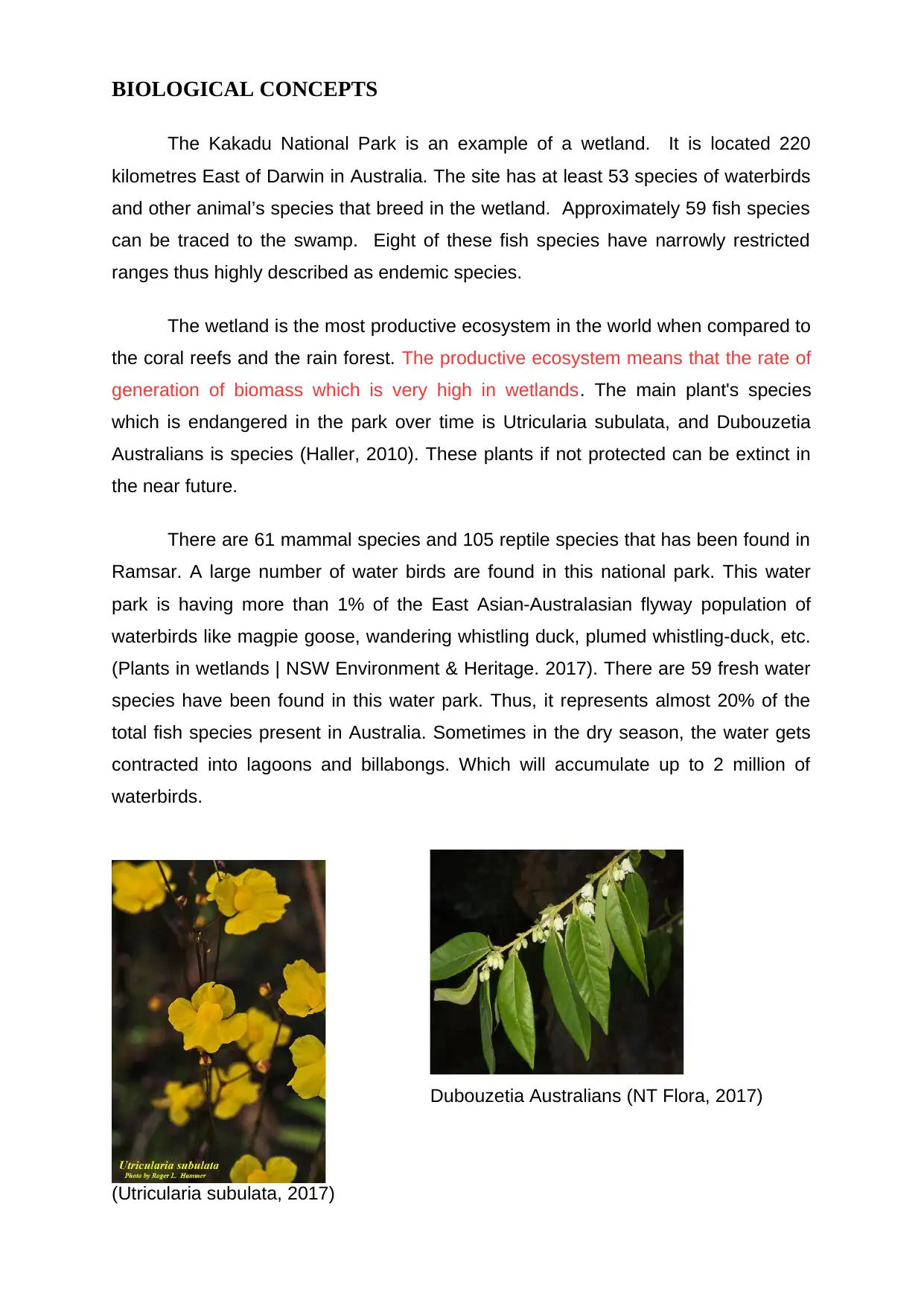
BIOLOGICAL CONCEPTS
The Kakadu National Park is an example of a wetland. It is located 220
kilometres East of Darwin in Australia. The site has at least 53 species of waterbirds
and other animal’s species that breed in the wetland. Approximately 59 fish species
can be traced to the swamp. Eight of these fish species have narrowly restricted
ranges thus highly described as endemic species.
The wetland is the most productive ecosystem in the world when compared to
the coral reefs and the rain forest. The productive ecosystem means that the rate of
generation of biomass which is very high in wetlands. The main plant's species
which is endangered in the park over time is Utricularia subulata, and Dubouzetia
Australians is species (Haller, 2010). These plants if not protected can be extinct in
the near future.
There are 61 mammal species and 105 reptile species that has been found in
Ramsar. A large number of water birds are found in this national park. This water
park is having more than 1% of the East Asian-Australasian flyway population of
waterbirds like magpie goose, wandering whistling duck, plumed whistling-duck, etc.
(Plants in wetlands | NSW Environment & Heritage. 2017). There are 59 fresh water
species have been found in this water park. Thus, it represents almost 20% of the
total fish species present in Australia. Sometimes in the dry season, the water gets
contracted into lagoons and billabongs. Which will accumulate up to 2 million of
waterbirds.
(Utricularia subulata, 2017)
Dubouzetia Australians (NT Flora, 2017)
The Kakadu National Park is an example of a wetland. It is located 220
kilometres East of Darwin in Australia. The site has at least 53 species of waterbirds
and other animal’s species that breed in the wetland. Approximately 59 fish species
can be traced to the swamp. Eight of these fish species have narrowly restricted
ranges thus highly described as endemic species.
The wetland is the most productive ecosystem in the world when compared to
the coral reefs and the rain forest. The productive ecosystem means that the rate of
generation of biomass which is very high in wetlands. The main plant's species
which is endangered in the park over time is Utricularia subulata, and Dubouzetia
Australians is species (Haller, 2010). These plants if not protected can be extinct in
the near future.
There are 61 mammal species and 105 reptile species that has been found in
Ramsar. A large number of water birds are found in this national park. This water
park is having more than 1% of the East Asian-Australasian flyway population of
waterbirds like magpie goose, wandering whistling duck, plumed whistling-duck, etc.
(Plants in wetlands | NSW Environment & Heritage. 2017). There are 59 fresh water
species have been found in this water park. Thus, it represents almost 20% of the
total fish species present in Australia. Sometimes in the dry season, the water gets
contracted into lagoons and billabongs. Which will accumulate up to 2 million of
waterbirds.
(Utricularia subulata, 2017)
Dubouzetia Australians (NT Flora, 2017)
⊘ This is a preview!⊘
Do you want full access?
Subscribe today to unlock all pages.

Trusted by 1+ million students worldwide
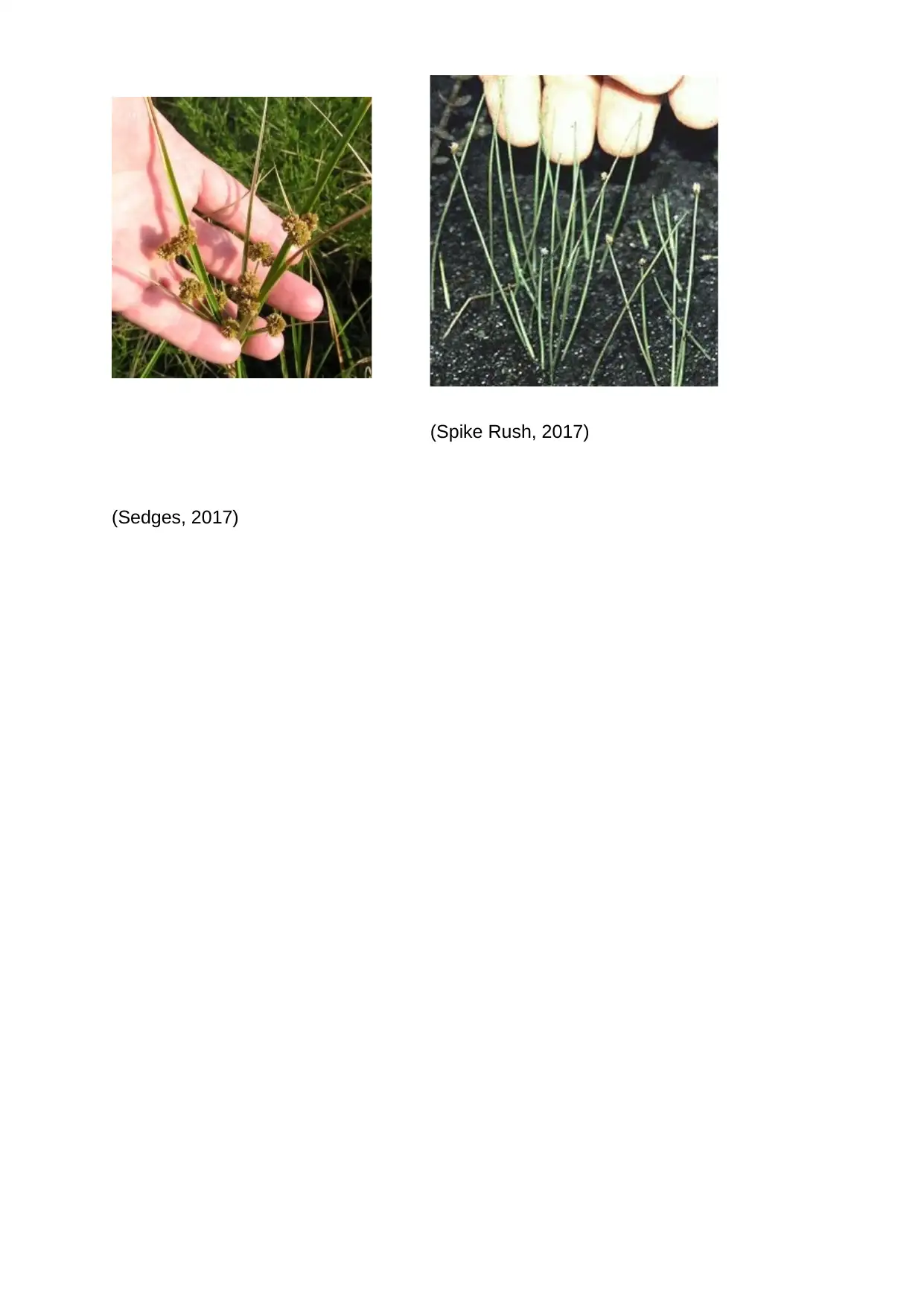
(Sedges, 2017)
(Spike Rush, 2017)
(Spike Rush, 2017)
Paraphrase This Document
Need a fresh take? Get an instant paraphrase of this document with our AI Paraphraser
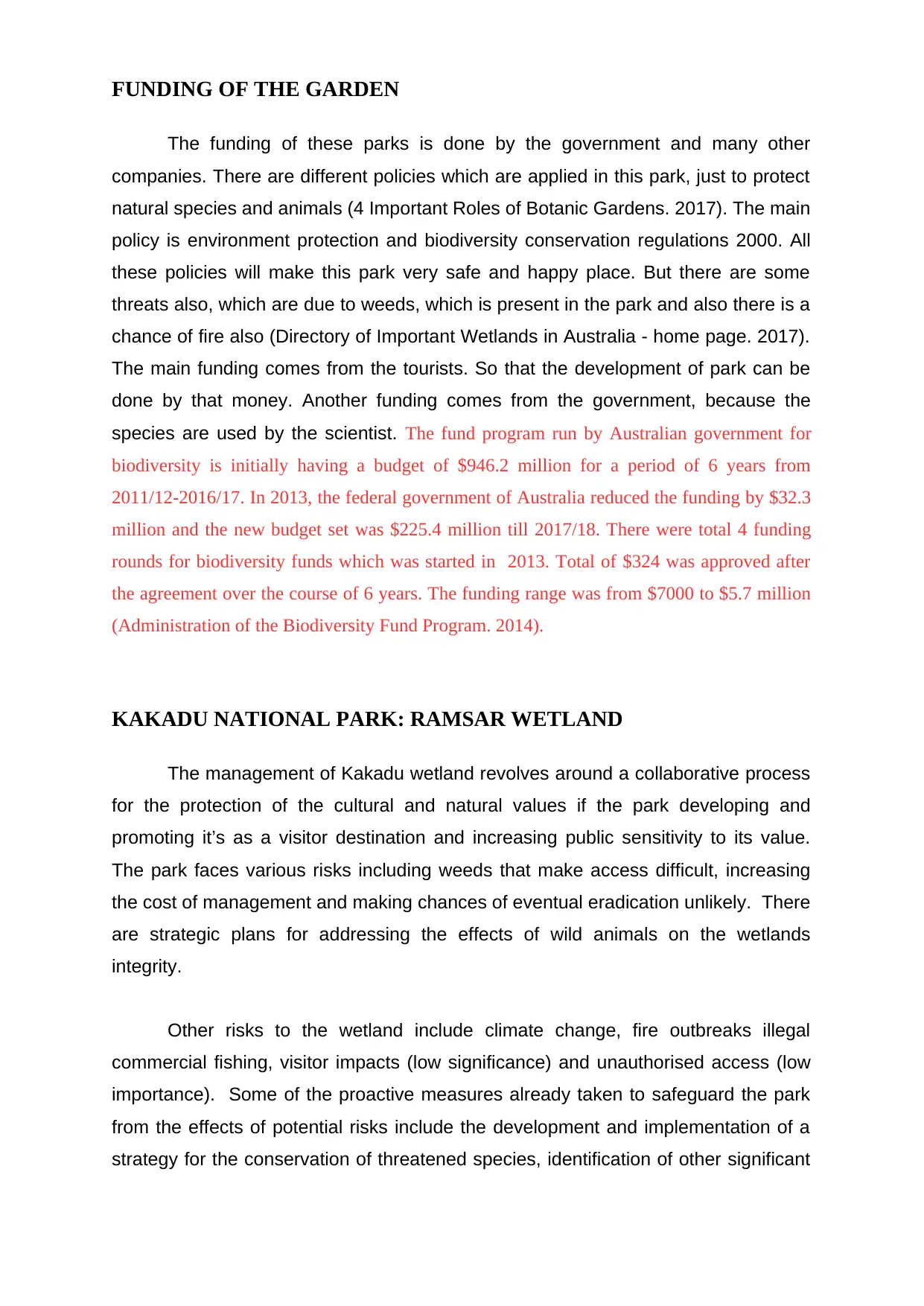
FUNDING OF THE GARDEN
The funding of these parks is done by the government and many other
companies. There are different policies which are applied in this park, just to protect
natural species and animals (4 Important Roles of Botanic Gardens. 2017). The main
policy is environment protection and biodiversity conservation regulations 2000. All
these policies will make this park very safe and happy place. But there are some
threats also, which are due to weeds, which is present in the park and also there is a
chance of fire also (Directory of Important Wetlands in Australia - home page. 2017).
The main funding comes from the tourists. So that the development of park can be
done by that money. Another funding comes from the government, because the
species are used by the scientist. The fund program run by Australian government for
biodiversity is initially having a budget of $946.2 million for a period of 6 years from
2011/12-2016/17. In 2013, the federal government of Australia reduced the funding by $32.3
million and the new budget set was $225.4 million till 2017/18. There were total 4 funding
rounds for biodiversity funds which was started in 2013. Total of $324 was approved after
the agreement over the course of 6 years. The funding range was from $7000 to $5.7 million
(Administration of the Biodiversity Fund Program. 2014).
KAKADU NATIONAL PARK: RAMSAR WETLAND
The management of Kakadu wetland revolves around a collaborative process
for the protection of the cultural and natural values if the park developing and
promoting it’s as a visitor destination and increasing public sensitivity to its value.
The park faces various risks including weeds that make access difficult, increasing
the cost of management and making chances of eventual eradication unlikely. There
are strategic plans for addressing the effects of wild animals on the wetlands
integrity.
Other risks to the wetland include climate change, fire outbreaks illegal
commercial fishing, visitor impacts (low significance) and unauthorised access (low
importance). Some of the proactive measures already taken to safeguard the park
from the effects of potential risks include the development and implementation of a
strategy for the conservation of threatened species, identification of other significant
The funding of these parks is done by the government and many other
companies. There are different policies which are applied in this park, just to protect
natural species and animals (4 Important Roles of Botanic Gardens. 2017). The main
policy is environment protection and biodiversity conservation regulations 2000. All
these policies will make this park very safe and happy place. But there are some
threats also, which are due to weeds, which is present in the park and also there is a
chance of fire also (Directory of Important Wetlands in Australia - home page. 2017).
The main funding comes from the tourists. So that the development of park can be
done by that money. Another funding comes from the government, because the
species are used by the scientist. The fund program run by Australian government for
biodiversity is initially having a budget of $946.2 million for a period of 6 years from
2011/12-2016/17. In 2013, the federal government of Australia reduced the funding by $32.3
million and the new budget set was $225.4 million till 2017/18. There were total 4 funding
rounds for biodiversity funds which was started in 2013. Total of $324 was approved after
the agreement over the course of 6 years. The funding range was from $7000 to $5.7 million
(Administration of the Biodiversity Fund Program. 2014).
KAKADU NATIONAL PARK: RAMSAR WETLAND
The management of Kakadu wetland revolves around a collaborative process
for the protection of the cultural and natural values if the park developing and
promoting it’s as a visitor destination and increasing public sensitivity to its value.
The park faces various risks including weeds that make access difficult, increasing
the cost of management and making chances of eventual eradication unlikely. There
are strategic plans for addressing the effects of wild animals on the wetlands
integrity.
Other risks to the wetland include climate change, fire outbreaks illegal
commercial fishing, visitor impacts (low significance) and unauthorised access (low
importance). Some of the proactive measures already taken to safeguard the park
from the effects of potential risks include the development and implementation of a
strategy for the conservation of threatened species, identification of other significant

species, conducting survey and monitoring programs for critical species and
continued mapping of the park.
continued mapping of the park.
⊘ This is a preview!⊘
Do you want full access?
Subscribe today to unlock all pages.

Trusted by 1+ million students worldwide
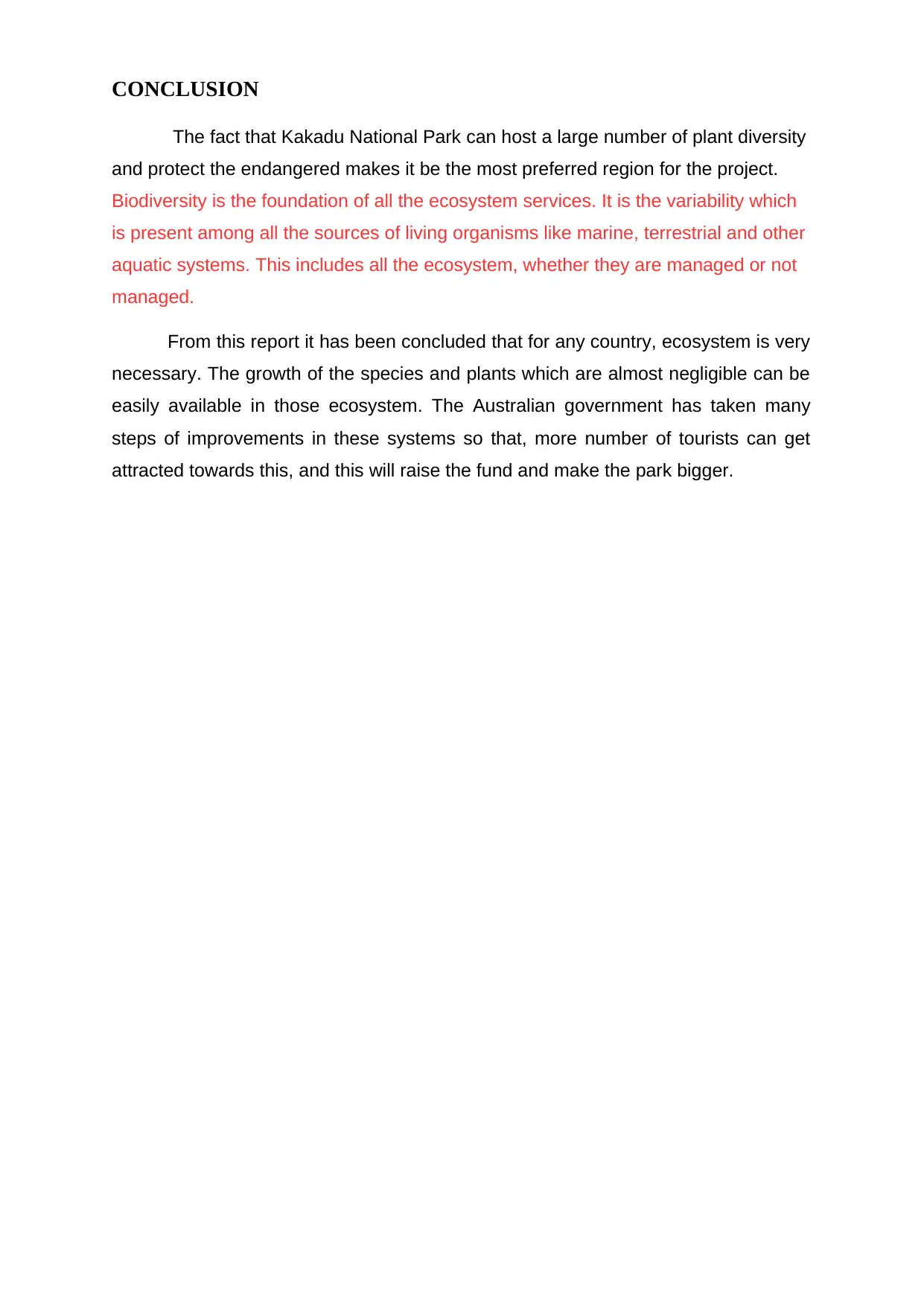
CONCLUSION
The fact that Kakadu National Park can host a large number of plant diversity
and protect the endangered makes it be the most preferred region for the project.
Biodiversity is the foundation of all the ecosystem services. It is the variability which
is present among all the sources of living organisms like marine, terrestrial and other
aquatic systems. This includes all the ecosystem, whether they are managed or not
managed.
From this report it has been concluded that for any country, ecosystem is very
necessary. The growth of the species and plants which are almost negligible can be
easily available in those ecosystem. The Australian government has taken many
steps of improvements in these systems so that, more number of tourists can get
attracted towards this, and this will raise the fund and make the park bigger.
The fact that Kakadu National Park can host a large number of plant diversity
and protect the endangered makes it be the most preferred region for the project.
Biodiversity is the foundation of all the ecosystem services. It is the variability which
is present among all the sources of living organisms like marine, terrestrial and other
aquatic systems. This includes all the ecosystem, whether they are managed or not
managed.
From this report it has been concluded that for any country, ecosystem is very
necessary. The growth of the species and plants which are almost negligible can be
easily available in those ecosystem. The Australian government has taken many
steps of improvements in these systems so that, more number of tourists can get
attracted towards this, and this will raise the fund and make the park bigger.
Paraphrase This Document
Need a fresh take? Get an instant paraphrase of this document with our AI Paraphraser

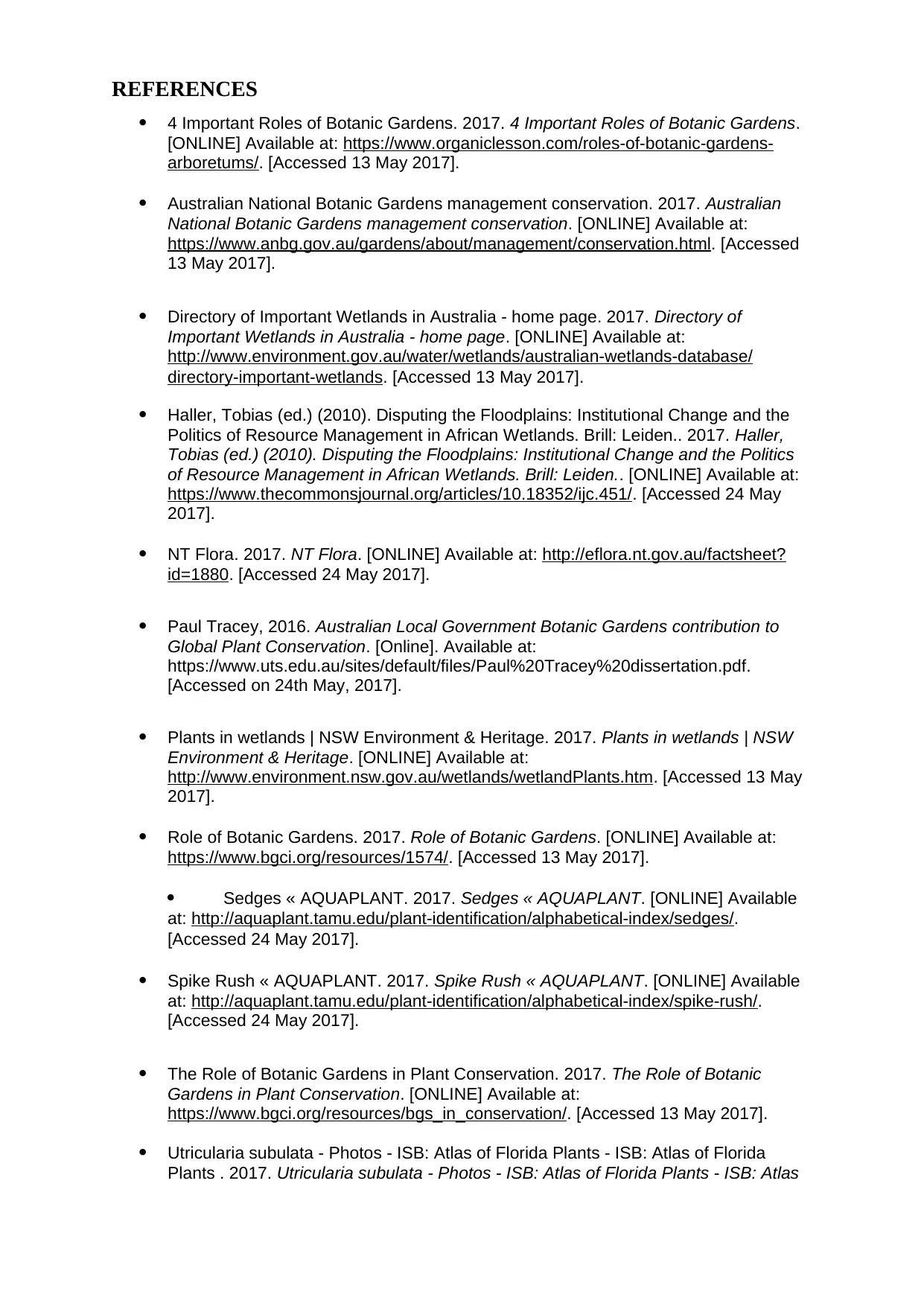
REFERENCES
4 Important Roles of Botanic Gardens. 2017. 4 Important Roles of Botanic Gardens.
[ONLINE] Available at: https://www.organiclesson.com/roles-of-botanic-gardens-
arboretums/. [Accessed 13 May 2017].
Australian National Botanic Gardens management conservation. 2017. Australian
National Botanic Gardens management conservation. [ONLINE] Available at:
https://www.anbg.gov.au/gardens/about/management/conservation.html. [Accessed
13 May 2017].
Directory of Important Wetlands in Australia - home page. 2017. Directory of
Important Wetlands in Australia - home page. [ONLINE] Available at:
http://www.environment.gov.au/water/wetlands/australian-wetlands-database/
directory-important-wetlands. [Accessed 13 May 2017].
Haller, Tobias (ed.) (2010). Disputing the Floodplains: Institutional Change and the
Politics of Resource Management in African Wetlands. Brill: Leiden.. 2017. Haller,
Tobias (ed.) (2010). Disputing the Floodplains: Institutional Change and the Politics
of Resource Management in African Wetlands. Brill: Leiden.. [ONLINE] Available at:
https://www.thecommonsjournal.org/articles/10.18352/ijc.451/. [Accessed 24 May
2017].
NT Flora. 2017. NT Flora. [ONLINE] Available at: http://eflora.nt.gov.au/factsheet?
id=1880. [Accessed 24 May 2017].
Paul Tracey, 2016. Australian Local Government Botanic Gardens contribution to
Global Plant Conservation. [Online]. Available at:
https://www.uts.edu.au/sites/default/files/Paul%20Tracey%20dissertation.pdf.
[Accessed on 24th May, 2017].
Plants in wetlands | NSW Environment & Heritage. 2017. Plants in wetlands | NSW
Environment & Heritage. [ONLINE] Available at:
http://www.environment.nsw.gov.au/wetlands/wetlandPlants.htm. [Accessed 13 May
2017].
Role of Botanic Gardens. 2017. Role of Botanic Gardens. [ONLINE] Available at:
https://www.bgci.org/resources/1574/. [Accessed 13 May 2017].
Sedges « AQUAPLANT. 2017. Sedges « AQUAPLANT. [ONLINE] Available
at: http://aquaplant.tamu.edu/plant-identification/alphabetical-index/sedges/.
[Accessed 24 May 2017].
Spike Rush « AQUAPLANT. 2017. Spike Rush « AQUAPLANT. [ONLINE] Available
at: http://aquaplant.tamu.edu/plant-identification/alphabetical-index/spike-rush/.
[Accessed 24 May 2017].
The Role of Botanic Gardens in Plant Conservation. 2017. The Role of Botanic
Gardens in Plant Conservation. [ONLINE] Available at:
https://www.bgci.org/resources/bgs_in_conservation/. [Accessed 13 May 2017].
Utricularia subulata - Photos - ISB: Atlas of Florida Plants - ISB: Atlas of Florida
Plants . 2017. Utricularia subulata - Photos - ISB: Atlas of Florida Plants - ISB: Atlas
4 Important Roles of Botanic Gardens. 2017. 4 Important Roles of Botanic Gardens.
[ONLINE] Available at: https://www.organiclesson.com/roles-of-botanic-gardens-
arboretums/. [Accessed 13 May 2017].
Australian National Botanic Gardens management conservation. 2017. Australian
National Botanic Gardens management conservation. [ONLINE] Available at:
https://www.anbg.gov.au/gardens/about/management/conservation.html. [Accessed
13 May 2017].
Directory of Important Wetlands in Australia - home page. 2017. Directory of
Important Wetlands in Australia - home page. [ONLINE] Available at:
http://www.environment.gov.au/water/wetlands/australian-wetlands-database/
directory-important-wetlands. [Accessed 13 May 2017].
Haller, Tobias (ed.) (2010). Disputing the Floodplains: Institutional Change and the
Politics of Resource Management in African Wetlands. Brill: Leiden.. 2017. Haller,
Tobias (ed.) (2010). Disputing the Floodplains: Institutional Change and the Politics
of Resource Management in African Wetlands. Brill: Leiden.. [ONLINE] Available at:
https://www.thecommonsjournal.org/articles/10.18352/ijc.451/. [Accessed 24 May
2017].
NT Flora. 2017. NT Flora. [ONLINE] Available at: http://eflora.nt.gov.au/factsheet?
id=1880. [Accessed 24 May 2017].
Paul Tracey, 2016. Australian Local Government Botanic Gardens contribution to
Global Plant Conservation. [Online]. Available at:
https://www.uts.edu.au/sites/default/files/Paul%20Tracey%20dissertation.pdf.
[Accessed on 24th May, 2017].
Plants in wetlands | NSW Environment & Heritage. 2017. Plants in wetlands | NSW
Environment & Heritage. [ONLINE] Available at:
http://www.environment.nsw.gov.au/wetlands/wetlandPlants.htm. [Accessed 13 May
2017].
Role of Botanic Gardens. 2017. Role of Botanic Gardens. [ONLINE] Available at:
https://www.bgci.org/resources/1574/. [Accessed 13 May 2017].
Sedges « AQUAPLANT. 2017. Sedges « AQUAPLANT. [ONLINE] Available
at: http://aquaplant.tamu.edu/plant-identification/alphabetical-index/sedges/.
[Accessed 24 May 2017].
Spike Rush « AQUAPLANT. 2017. Spike Rush « AQUAPLANT. [ONLINE] Available
at: http://aquaplant.tamu.edu/plant-identification/alphabetical-index/spike-rush/.
[Accessed 24 May 2017].
The Role of Botanic Gardens in Plant Conservation. 2017. The Role of Botanic
Gardens in Plant Conservation. [ONLINE] Available at:
https://www.bgci.org/resources/bgs_in_conservation/. [Accessed 13 May 2017].
Utricularia subulata - Photos - ISB: Atlas of Florida Plants - ISB: Atlas of Florida
Plants . 2017. Utricularia subulata - Photos - ISB: Atlas of Florida Plants - ISB: Atlas
⊘ This is a preview!⊘
Do you want full access?
Subscribe today to unlock all pages.

Trusted by 1+ million students worldwide
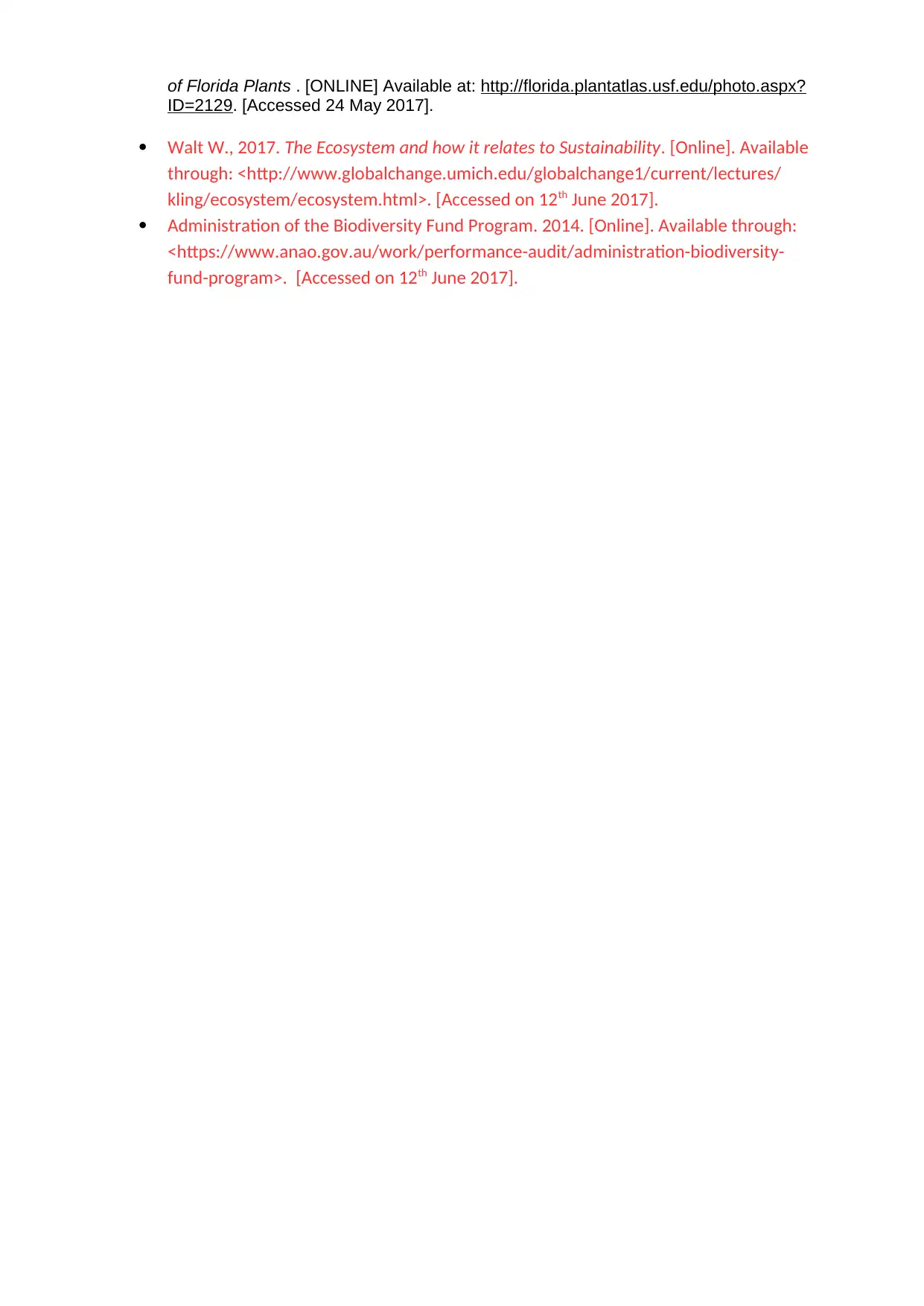
of Florida Plants . [ONLINE] Available at: http://florida.plantatlas.usf.edu/photo.aspx?
ID=2129. [Accessed 24 May 2017].
Walt W., 2017. The Ecosystem and how it relates to Sustainability. [Online]. Available
through: <http://www.globalchange.umich.edu/globalchange1/current/lectures/
kling/ecosystem/ecosystem.html>. [Accessed on 12th June 2017].
Administration of the Biodiversity Fund Program. 2014. [Online]. Available through:
<https://www.anao.gov.au/work/performance-audit/administration-biodiversity-
fund-program>. [Accessed on 12th June 2017].
ID=2129. [Accessed 24 May 2017].
Walt W., 2017. The Ecosystem and how it relates to Sustainability. [Online]. Available
through: <http://www.globalchange.umich.edu/globalchange1/current/lectures/
kling/ecosystem/ecosystem.html>. [Accessed on 12th June 2017].
Administration of the Biodiversity Fund Program. 2014. [Online]. Available through:
<https://www.anao.gov.au/work/performance-audit/administration-biodiversity-
fund-program>. [Accessed on 12th June 2017].
Paraphrase This Document
Need a fresh take? Get an instant paraphrase of this document with our AI Paraphraser
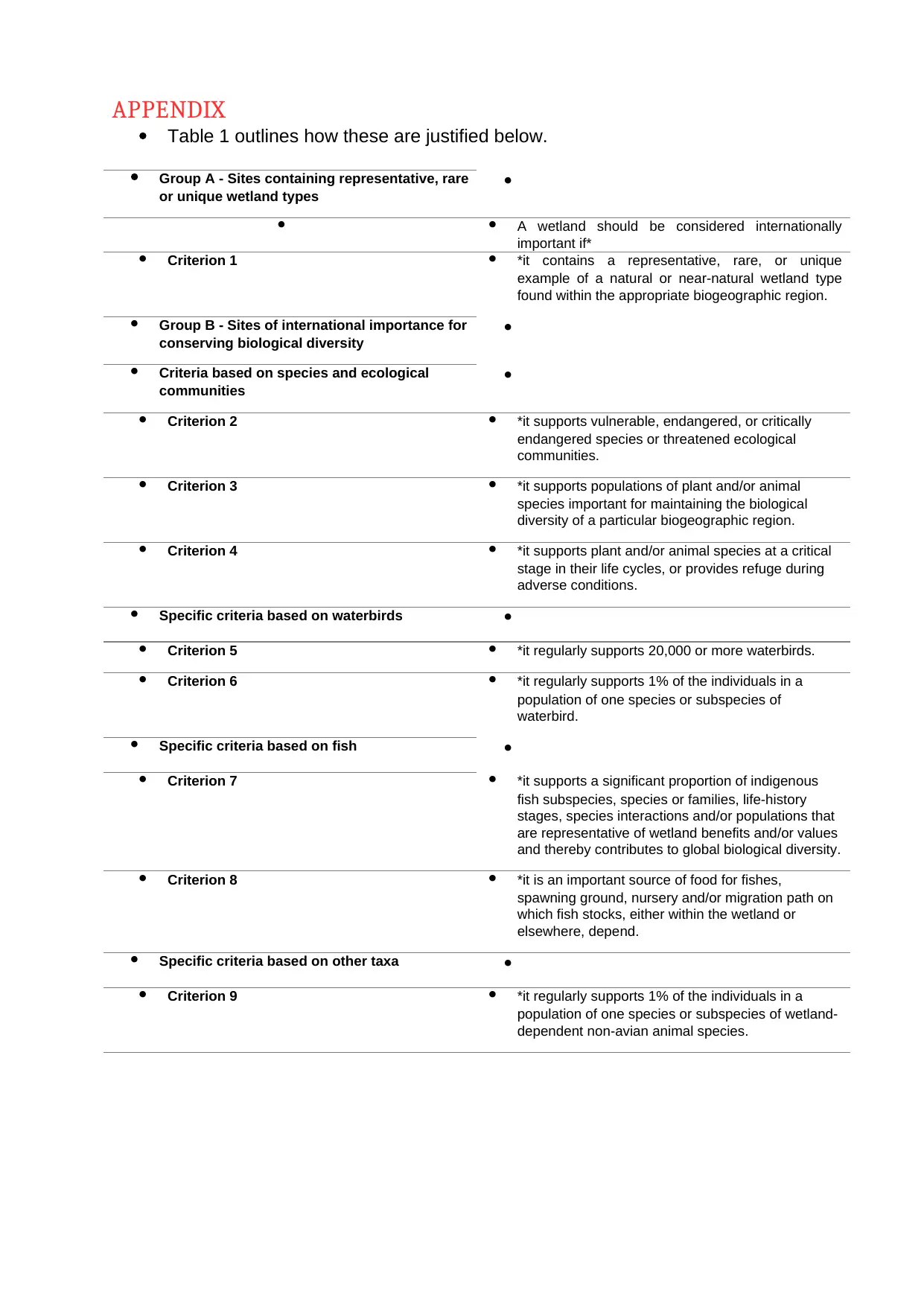
APPENDIX
Table 1 outlines how these are justified below.
Group A - Sites containing representative, rare
or unique wetland types
A wetland should be considered internationally
important if*
Criterion 1 *it contains a representative, rare, or unique
example of a natural or near-natural wetland type
found within the appropriate biogeographic region.
Group B - Sites of international importance for
conserving biological diversity
Criteria based on species and ecological
communities
Criterion 2 *it supports vulnerable, endangered, or critically
endangered species or threatened ecological
communities.
Criterion 3 *it supports populations of plant and/or animal
species important for maintaining the biological
diversity of a particular biogeographic region.
Criterion 4 *it supports plant and/or animal species at a critical
stage in their life cycles, or provides refuge during
adverse conditions.
Specific criteria based on waterbirds
Criterion 5 *it regularly supports 20,000 or more waterbirds.
Criterion 6 *it regularly supports 1% of the individuals in a
population of one species or subspecies of
waterbird.
Specific criteria based on fish
Criterion 7 *it supports a significant proportion of indigenous
fish subspecies, species or families, life-history
stages, species interactions and/or populations that
are representative of wetland benefits and/or values
and thereby contributes to global biological diversity.
Criterion 8 *it is an important source of food for fishes,
spawning ground, nursery and/or migration path on
which fish stocks, either within the wetland or
elsewhere, depend.
Specific criteria based on other taxa
Criterion 9 *it regularly supports 1% of the individuals in a
population of one species or subspecies of wetland-
dependent non-avian animal species.
Table 1 outlines how these are justified below.
Group A - Sites containing representative, rare
or unique wetland types
A wetland should be considered internationally
important if*
Criterion 1 *it contains a representative, rare, or unique
example of a natural or near-natural wetland type
found within the appropriate biogeographic region.
Group B - Sites of international importance for
conserving biological diversity
Criteria based on species and ecological
communities
Criterion 2 *it supports vulnerable, endangered, or critically
endangered species or threatened ecological
communities.
Criterion 3 *it supports populations of plant and/or animal
species important for maintaining the biological
diversity of a particular biogeographic region.
Criterion 4 *it supports plant and/or animal species at a critical
stage in their life cycles, or provides refuge during
adverse conditions.
Specific criteria based on waterbirds
Criterion 5 *it regularly supports 20,000 or more waterbirds.
Criterion 6 *it regularly supports 1% of the individuals in a
population of one species or subspecies of
waterbird.
Specific criteria based on fish
Criterion 7 *it supports a significant proportion of indigenous
fish subspecies, species or families, life-history
stages, species interactions and/or populations that
are representative of wetland benefits and/or values
and thereby contributes to global biological diversity.
Criterion 8 *it is an important source of food for fishes,
spawning ground, nursery and/or migration path on
which fish stocks, either within the wetland or
elsewhere, depend.
Specific criteria based on other taxa
Criterion 9 *it regularly supports 1% of the individuals in a
population of one species or subspecies of wetland-
dependent non-avian animal species.
1 out of 11
Your All-in-One AI-Powered Toolkit for Academic Success.
+13062052269
info@desklib.com
Available 24*7 on WhatsApp / Email
![[object Object]](/_next/static/media/star-bottom.7253800d.svg)
Unlock your academic potential
Copyright © 2020–2025 A2Z Services. All Rights Reserved. Developed and managed by ZUCOL.

